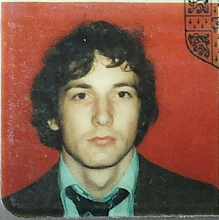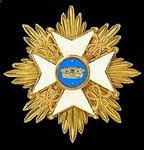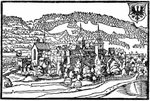Most of the French cavalry standards are blue or red with gold embroidery so it is refreshing to find a yellow standard with silver; this is also an interesting unit for having served in the '45 on the Jacobite side. Many wargamers depict this unit, whose uniform is also an attractive one. The flag is a slight cheat, as we do not know the emblem on the reverse of the standard, so it is given the usual sun emblem and motto.
Raised first 1691 as Roi d'Angleterre by James II from Jacobite exiles in France. It fought in the battle of Landen in 1693. In 1698 it was incorporated in the French army.
Standard carried from 1740-1762.
During the War of the Spanish Succession it served in Germany then Italy where it was in the battle of Luzzara in 1702. Back in Germany it was at the sieges of Brisach and Landau in 1703. Then in Flanders it was at Ramillies 1706, Oudenarde 1708, Malplaquet 1709, Denain 1712 and then the siege of Douai 1712. In 1713 it was back on the Rhine and at the sieges of Landau and Freiburg.
Served on the Rhine in the War of the Polish Succession.
During the War of the Austrian Succession the regiment was at first with the Army of Bohemia. It was in Alsace in 1743. In Flanders 1745 it took part in the sieges of Tournai, Oudenarde and Termonde. In that year the regiment was sent to Scotland to help Bonnie Prince Charlie in the '45. 3 of its 4 squadrons were captured at sea but the remaining squadron reached Scotland and served at Culloden. Christopher Duffy in His Fight For A Throne: The Jacobite '45 Reconsidered says that the surviving squadron reached Aberdeen on 22nd February 1745; it consisted of about 130 officers and men but lacked horses. He says they counted as cuirassiers, the only such unit on either side in the 45. "Its needs were given priority an dit apporiated the mounts of Kilmarnock's Horseguards. Hard - though valuable - service reduced FitzJames's effectives to about 70 by the time of Culloden, where they were positioned alongside Elcho's Lifeguards on the right wing of the second line. Apart from their iron breastplates - painted black - the Irish troopers (in their red coats) were uniformed almost identically with the enemy dragoons and light horse." Near the end of the battle they probably help shield the retreating right wing of the Jacobite army from their pursuers. Having been captured at Inverness the survivors were repatriated to France and the regiment remade. Sent to Flanders it was at the battle of Rocoux in 1746, Lauffeld in 1747 then at the siege of Bergen op Zoom. In 1748 it was at the siege of Maastricht.
In 1756 the regiment was 2 squadrons strong and ranked 56th. It was disbanded on 21st December 1762.
In late 1757 the regiment joined the Army of Saxony led by the Prince de Soubise. Christopher Duff in his Prussia's Glory calls them "disorderly (and very well paid)". At Rossbach on November 5th, along with the regiments of Bourbon, Beauvoisis and Rougrave, all commanded by the Comte de Mailly, the regiment initially stood its ground against the first Prussian cavalry attack until they were eventually swept away. Duffy reports that "the Fitz-James Regiment had lost two standards and its drums (probably from being amongst the last to leave the field, as at Culloden in 1746)".
In 1758 the regiment joined the army of the Comte de Clermont on the Lower Rhine but later in the year was employed guarding the coast.
In 1760 the regiment was with Broglie's army and may have been with Camille's cavalry corps which was just too late for the combat of Corbach.
On 24th June 1762 the regiment was badly cut up as part of the rearguard after the battle of Wilhelmstahl.
[Text based mostly on Kronoskaf plus the two Duffy volumes mentioned.]
The two uniform plates show the dress with and without the bearskin that is mentioned from 1755.
And these are either probable flags on the way (Piedmontese) or possibles (the Genoese):























